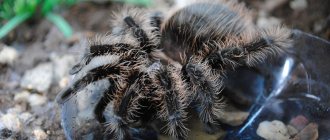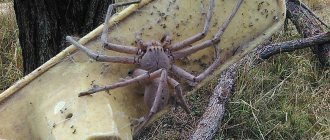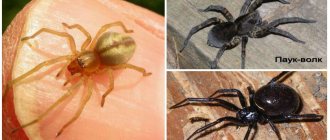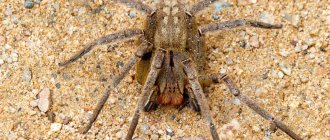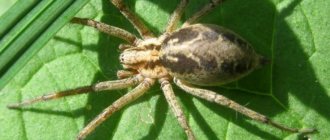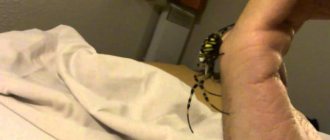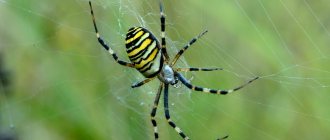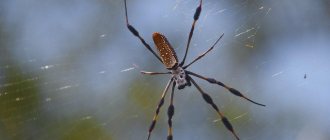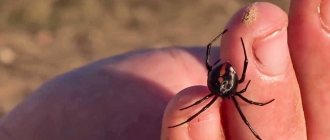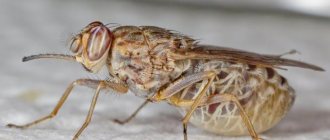If you like to walk through the forest, then you have probably come across a large spider with a cross on its back, weaving skillful webs in tree branches. That's what it's called - a cross. This is the most common genus of arachnids in our latitudes, numbering over 2 thousand species. Should we be afraid of crosses? You may not be afraid, but you should be afraid. The arthropod avoids contact with humans, but if you try to catch it or crush it inadvertently, a rather painful bite cannot be avoided.
General information
How long the cross spider lives and what it looks like depends on its type:
- An ordinary cross. This is the most common of all spiders with a cross on its back. The size of females reaches 2.0-2.5 cm in length, and males - 1.1 cm. In addition, males have a narrower body. In both sexes, the body is covered with a waxy substance that retains water. The cephalothorax is protected by a reliable shell.
- Spider with a red cross. This species is characterized by small body size. Their color differs depending on the lighting. On the back there is a pattern resembling a red cross. Other body features do not differ from a regular cross.
- Barn spider. Females and males of this species of arthropod are approximately the same size. Females reach 1.3-2.2 cm in length, and males - 1.0-2.0 cm. This is a yellow spider, the center of its abdomen is represented by uneven brown notches. A dark stripe with two dazzling white spots runs along the lower part of the body.
- Meadow cross. Mainly lives where there is moisture and a lot of grass. The cross on it is dark or light in color. A blurry pattern resembling a leaf is visualized at the bottom. The body has a light green or brown tint. Light stripes are visible on the paws. The body length of a female is 1.7 cm, and that of a male is 0.8 cm. Females blend into their environment, changing their color, like chameleons.
- Marble cross. This species is characterized by pronounced sexual dimorphism. Females are significantly larger than males in size. Their length reaches 1.8 cm, males - up to 0.8 cm. These arthropods have a variety of shades and patterns. But most often they have an orange belly and a black pattern. This combination of colors served as the choice for the name of the species.
A pure black spider with a white cross on its back is just a work of human imagination. There are no representatives of this arthropod species with this color. The life cycle of different species of this arthropod varies within 1-2 years.
Let's get to know each other better
A spider with a cross on its back gave its name to a whole genus of arachnids, although not all cross spiders have such a striking sign. The arthropod belongs to the family of orb-weaving spiders. The species we are interested in is the common cross, it is common in the middle zone and in the south of Russia, it is afraid of the cold, so it does not climb into the northern regions.
What do crosses look like?
The female crosstail is larger than the male and can reach a length of 2.5 cm. The representative of the opposite sex is half that size. Let's dwell on the most striking identifying marks.
- Coloring. The body of the spider is yellowish-brown in color, covered with whitish, as if camouflage, spots. Individuals living in the sun have a darker color, while those living in the shade are lighter. On the upper part of the abdomen there are several oblong and round spots, forming a white pattern in the shape of a cross.
- Large round abdomen. If there is one, it means there is a “girl” in front of you. In males, the abdomen is narrow and not so convex.
- Many hairs that cover the cephalothorax, abdomen, and limbs. They perform not only a protective, but also a tactile function.
- Darker rings are visible on walking legs.
Otherwise, the structure of the spider with a cross is the same as that of other arachnids - 4 pairs of legs and simple eyes, a piercing-sucking type of mouthparts (maxilla). All this is located on the cephalothorax.
Habitat
The cross grass loves damp places protected from the sun, so it settles in thickets of bushes, trees, and tall grass. The “unsociable” nature of the hermit is manifested in the fact that he can more often be found in neglected places - in abandoned plots, wild gardens, in dilapidated country houses. Here the spider with the cross on its back has plenty of freedom - know, weave everything with a hunting web, no one will disturb you.
Is the cross spider dangerous for humans?
The cross spider is poisonous. When biting insects or humans, it readily releases a toxic substance. Most often this occurs when the crusader comes into direct contact with a person’s hand.
The bite of the cross spider is not fatal to people, but after the incident the following symptoms develop:
- slight disturbance of spatial orientation;
- cephalgia;
- feeling of general weakness;
- aching joints;
- soreness throughout the body;
- the bite site itches, tingles, turns red;
- small hematomas appear.
Although the spider's venom does not cause death, first aid should not be neglected. After a bite, it is useful to do the following:
- Wash the pathological lesion with soap and water to avoid additional infection.
- Apply ice or any cold object to the bitten area.
- If you have a fever or headache, take an NSAID or antipyretic.
- A person prone to allergies should take an antihistamine to prevent the development of unwanted reactions in the body.
If a child is bitten by a cross spider, he should be taken to the hospital and shown to a doctor. To avoid being bitten by an arthropod, it is important to adhere to the following rules:
- When camping in the forest with tents, it is important to cover your sleeping area well at night and use a mosquito net.
- Before going to bed outdoors or in the morning, you need to carefully inspect your sleeping place, clothes and shoes for the presence of spiders or various insects.
- A great danger can be posed by cobwebs along the way. It is better not to come into contact with it, since female spiders sit on it, waiting for a new victim.
- Arriving at a camp site or an old, uninhabited house, you should inspect all the cracks. It is also important to ensure that these arthropods do not weave their webs in dacha gardens.
When faced with a cross spider, under no circumstances should you pick it up. It is also important to teach this to your children in advance.
Benefits for humans
People actively use the web of crosses. It is ideal for sighters of various optical instruments: microscopes, telescopic sights. And microbiologists, with its help, invented an innovative air analyzer.
The crosser is placed on a special frame, fed, and he weaves his net on its basis. Then a portion of air is passed through this frame, and the thinnest web traps pathogenic microorganisms that fill the air space. This method of air analysis has been recognized as the most effective of all existing in the world.
Folk healers have long used spider webs to disinfect open wounds. Over time, medical research has confirmed that spider webs actually kill pathogenic bacteria. Based on it, drugs were developed that are harmless to animals, but destructive to all kinds of bacteria.
Symptoms of cross bites
For large animals and humans, the venom of the cross spider is not particularly dangerous, because it is too small to cause significant harm to a large organism.
Maxim, when it is possible to kill a mouse or a rat with this dose.
And yet, the bite of a spider of this species is not completely harmless. If you accidentally fall into the web of this arthropod creature, a person may still suffer from its bites. After all, the spider takes as a victim anyone who causes its “catching net” to vibrate. And for the purpose of self-defense, of course, the spider will bite anyone.
The cross can also bite when a person tries to pick it up.
The clinical picture of spider bites will be as follows:
- The bite site turns white and looks like a bee sting;
- The spot grows the size of a nickel and turns red at the edges;
- Swelling at the puncture site;
- A burning sensation at the site of the bite.
And if a person suffers from allergic reactions, then it may well be that the bite of this insect will cause the following symptoms:
- General weakness of the body;
- Skin rashes in the form of red spots;
- Headache;
- Painful syndrome in the limbs;
- Increase in body temperature;
- Hardening at the site of the bite.
As a rule, greater sensitivity to cross bites is observed in children and allergy sufferers.
Therefore, these groups of people may experience not only the symptoms described above, but also develop more serious complications in the form of suffocation, intense swelling, and even disruption of the cardiovascular system.
If such a clinical picture develops, it is very important to immediately call a qualified medical team for emergency care and hospitalize the victim for adequate therapy and constant medical supervision.
Spider structure
The size of cross spiders depends on gender. On average, the male reaches up to 1.0 cm, and the female up to 2.0 cm. In some species, the length of female specimens reaches 2.6 cm. Arachnologists study the body parts of the cross spider with great interest.
External
The number of legs intended for walking in the cross spider is 8 pieces. In addition, it has 1 pair of pedipalps, which are responsible for recognizing and holding the victim. And also 1 pair of chelicerae (jaws). The spider uses them to attack and kill its prey. The oral appendages of arthropods point downward, and their hooks point inward.
The eyes (4 pairs) of the arthropod do not serve their purpose well. They allow you to see only blurry silhouettes, a flash of light or a shadow. But this disadvantage is compensated by a well-developed sense of touch. The entire surface of the spiders' body is covered with a large number of tactile hairs. They perceive chemical and sound stimuli, and also react to air currents.
The posterior part of the body is rounded and not divided into segments. On its lower part there are 3 pairs of warts with a large number of glands. They are necessary for the cross to produce a variety of threads that help it in various situations. With their help, they weave webs, make cocoons or arrange shelters.
Internal
The internal structure of the spider is also of great interest. Not all of his organs are located on his abdomen.
Digestion
Crosses have external digestion. They are unable to swallow whole food and then digest it. They are forced to build nets to catch prey. When the prey is in the web, the spider injects it with a special juice necessary for fermentation, wraps it in a cocoon, and then waits for the prey to digest and become a nutrient solution that the arthropod drinks.
Respiratory system
The spider's abdomen contains organs of the respiratory system. They are a pair of pulmonary sacs with a large number of leaf-like folds, as well as 2 bundles of tracheal tubes. They are filled with air and hemolymph (a biological fluid similar to blood that fills the spider’s vessels) flows through them to enrich them with oxygen.
The cardiovascular system
The Crusaders have an open circulatory system. The dorsal part of the abdomen contains the heart. Its appearance resembles a long tube with large blood vessels branching off. The anterior aorta, which branches into arteries, is connected to the anterior end of the heart.
From the terminal arterial branches, hemolymph enters the body of the crusader spider. While washing the internal organs, it supplies them with oxygen and nutrients. Gas exchange occurs when hemolymph flows through the pulmonary sacs. The hemolymph contains a blue pigment that contains copper.
Excretory system
In the cross spider, the excretory system is represented by coxal glands and malpighian vessels in the form of tubes. The latter are circular protrusions of the intestinal wall. They are localized between the midgut and hindgut, and allow waste products to be absorbed from the body cavity of the arthropod.
The coxal glands, in the form of two sacs, are located on the fused head and thoracic segments. They diverge into a system of canals that end in excretory ducts at the base of the legs intended for walking.
Description of spiders
Spiders have 8 legs. The body is divided into 2 parts, they are connected by a thin stalk. Most spiders have 8 eyes, some have 6. A few arachnids outside Europe have 4 or 2 eyes. Spiders' eyes do not have one location; it depends on the species. Some spiders have the same size eyes, others have different ones. Most spiders have poor vision. But some species have large front eyes with fairly good vision:
The easiest way to determine whether an arachnid is male or female is to look at the front tentacles. In females they are quite narrow; in spiders, the tips of the tentacles resemble boxing gloves. Males use them as pipettes to release sperm during mating.
Which spiders are endemic to Russia and Europe, the most common species
Range and habitats
Crossworts are found throughout the globe in temperate or tropical climates. Some species of such arthropods live in Europe, Asia, Africa, and also in North America. In their first year, spiders overwinter in the egg stage.
The habitat of the cross spider is damp, low-lying places, in the vicinity of which there are bodies of water. They also like forests, parks or gardens, where it is convenient to weave catching nets between the branches.
Sometimes a round web of crosses is found in window and door openings, as well as under the roofs of abandoned buildings.
Features of reproduction
In spiders, reproduction is accomplished by mating. By the end of the mating period, the male loses his life. And the fertilized female begins to weave a cocoon for eggs, which she usually lays with the onset of autumn.
At first, the female wears the cocoon on herself, and then throws it off in a secluded place (a gap in the bark of trees or in non-residential buildings). With the arrival of spring, young (juvenile) spiders crawl out of the cocoon. They become sexually mature towards the end of summer. And the female, who took care of their birth, dies by that time.
Cross spider: male and female
Diet
The diet of the crusader spider consists of various insects such as flies, wasps, hornets, grasshoppers, locusts, caterpillars, butterflies, etc. Snakes, mice, frogs, etc. get entangled in large webs woven from strong threads.
The spider does not have an internal digestive system, so it consumes liquefied food. After a spider bite, when the spider injects a portion of poison, the victim is immobilized. At the same moment, he injects a special secretion into the victim, which turns solid tissue into a liquid mass. After about 20 minutes maximum, the spider starts eating.
What does the cross spider eat?
The cross spider has a varied diet:
- fruit flies;
- any dipterous insects;
- wasps, bees, ants;
- grasshoppers;
- aphidids;
- other small insects.
To get its food, the cross is forced to build a web to catch prey. When a victim falls into the net, the spiders do not eat the food immediately, but wrap it in a cocoon and hide it. This is necessary so that the fermentation process takes place, and also so that other relatives do not covet the prey.
Reproduction process
The reproductive process in spiders begins at the end of summer. Mating occurs directly on the web, after which the female forms a cocoon and lays more than 200 eggs in it.
First, the female carries the cocoon with her, and after a while leaves it in a suitable place. In this cocoon, the future offspring overwinter and only in the spring in April the young are born.
Spiders grow and develop over several months, molting at least 5 times during this time. By the end of summer, young spiders are ready to continue their race. The young animals feed on caterpillars all this time.
Important point! Adult spiders look for suitable places to spend the winter. Such places can be cracks in the walls of various outbuildings, forest litter, and tree hollows. When the air temperature begins to rise in the spring, spiders begin to leave their shelters.
Interesting Facts
A spider with a cross has the following features:
- The web of the cross is of great interest. It is elastic and has high strength. Since ancient times it has been used to make fabrics or decorations. People from tropical countries weave nets and nets from it to catch fish.
- Microbiologists have also not ignored the spider web. They use it to determine the composition of atmospheric air, as well as to produce the thinnest optical fiber.
- Interestingly, spiders move freely through their trapping webs and do not stick to them. This is explained by the fact that they move along radial, dry threads.
Crossmen are unique creatures. They can be very useful for a person. But if, due to an unfortunate combination of circumstances, the arthropod still bites, then first aid measures should be taken. But there is no reason to seriously fear for your health after this.
What to do if you are bitten
The spider bite is not fatal to humans, cattle, horses, dogs, sheep, the danger exists only for rats, rabbits and mice.
Usually, the spider bites a person by accident if he falls into a web where a hunter is waiting for his prey. Its poison is a colorless, cloudy and viscous liquid.
Preventing a Bite
To avoid a spider bite, you should follow some simple recommendations:
- When going to bed in nature, be sure to close the entrance to the tent at night;
- Before going to bed, carefully examine your bed, clothes and shoes;
- be careful near the webs, remember that there is a cross nearby that is waiting for the victim;
- be careful during country and garden work;
- be vigilant when in abandoned old premises;
- If you find a cross, do not try to pick it up.
Symptoms
The cross spider is able to bite through only the thinnest skin. The pain of the bite is comparable to that of a bite; a person feels a prick with a thin needle, and sometimes does not notice anything at all.
A white spot with red or pink edges, small in size (no larger than a five-kopeck coin), appears at the site of the lesion.
The main signs of a spider bite that develop after 5-20 minutes include:
- irritation at the site of injury;
- aching joints;
- weakness;
- skin redness;
- slight chills;
- subcutaneous hemorrhages;
- slight increase in temperature;
- edema;
- hardening of the skin;
- headache;
- burning.
First actions after a bite
If you are bitten by a cross, the following actions should be taken:
- wash the affected area with running water and soap to eliminate the risk of infection;
- Apply ice or a cold compress to the bite site;
- if you have a fever or headache, it is recommended to take paracetamol;
- If you have an allergic reaction, take any antihistamine that does not require a prescription.
If there is a rapid increase in symptoms or a child has been bitten, it is recommended to seek help from a doctor.
Consequences
The cross releases epeirotoxin
, which is absorbed and completely eliminated from the human body within 24 hours. There may be slight swelling at the site of the bite for several days.
If there is no improvement in the person’s condition, the following actions should be taken:
- apply cold to the affected area;
- use anti-inflammatory ointments: Sinaflan, Kremgen;
- Lubricate the area with alcohol.
Do not scratch the site of a spider bite. This can lead to the development of a purulent process when infection enters the skin.
It makes no sense to burn or cut the skin when bitten; it does not have serious consequences. This is just additional trauma.
To date, not a single fatality has been reported from a cross bite. But in some cases, after recovery, soft tissue necrosis is observed at the affected area.
Exercise caution when out in nature. Remember that a cross spider will never attack a person on its own. Do not provoke a bite, and if affected, take measures to prevent complications from occurring.
Do not provoke a bite, and if affected, take measures to prevent complications.
You need to enable JavaScript to vote
